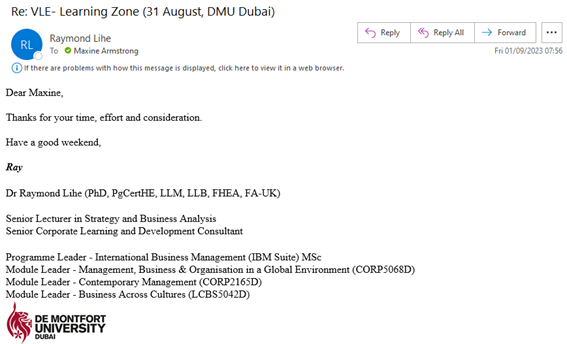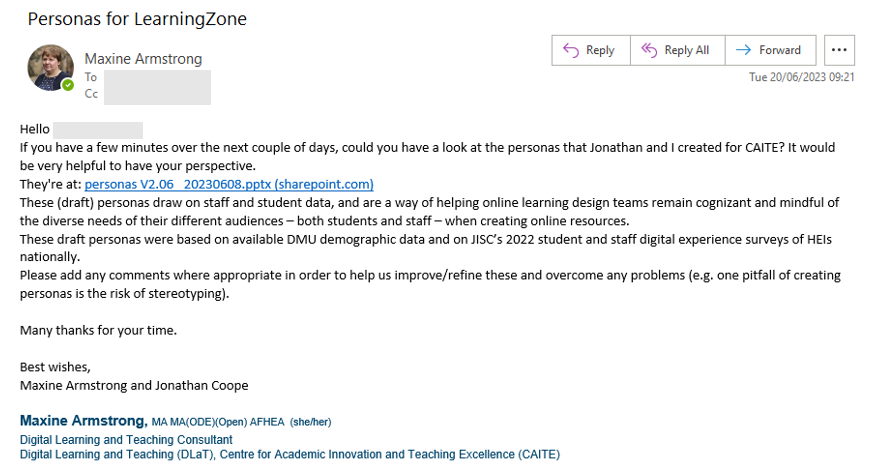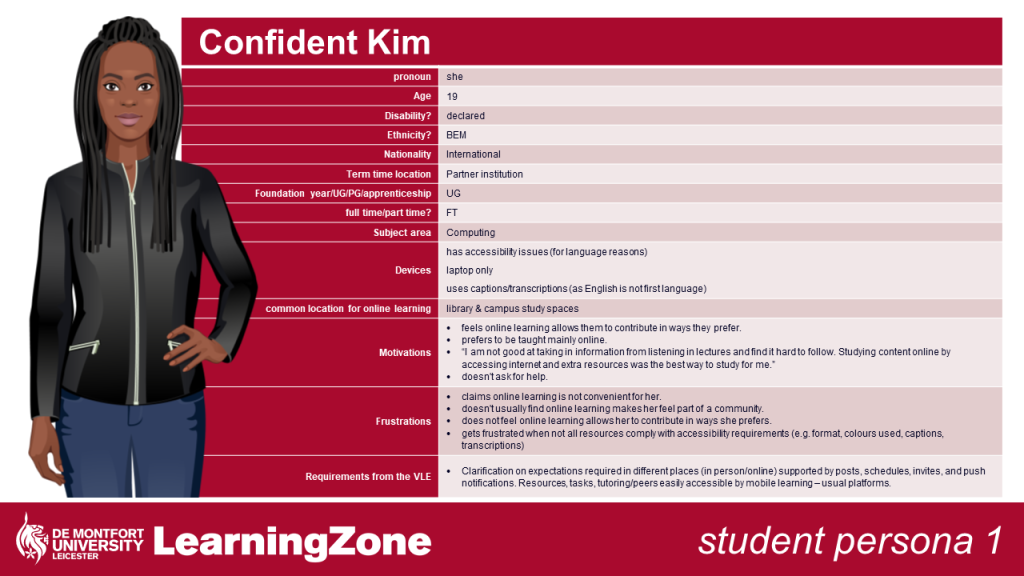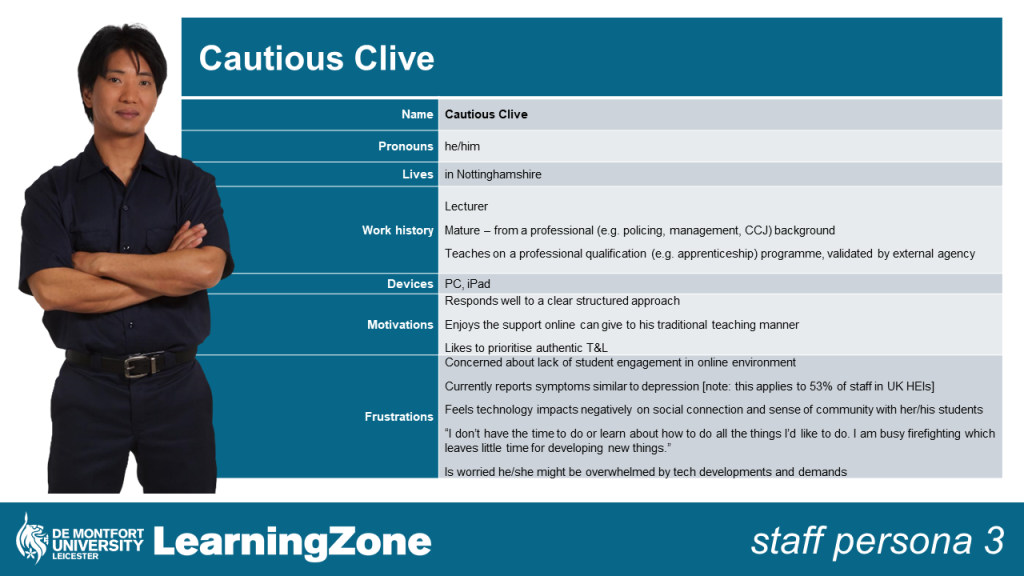a) An understanding of teaching, learning and/or assessment processes
I have a deep understanding of teaching, learning and assessment processes from my many years working in higher education. During this time, I also studied part-time for an MA in Online and Distance Education (Open University) in 2016, to help develop my theoretical understanding. In 2018 I was awarded Associate Fellow of Advance HE (AFHEA). In August 2023, I was awarded Fellow of Advance HE (FHEA).
During the current VLE transition, I have supported the DLAT team by contributing to the series of LearningZone Deep Dive sessions we held from March 2023, which provided workshop training for colleagues around key features of LearningZone, such as communication and assessments. I wrote the Content Creation session plan which all my colleagues followed when they delivered this training. I have also facilitated a number of bespoke training sessions for our Transnational Educational Partner institutions, such as Niels Brock Copenhagen Business College, Denmark and Daly College Business School, India. Thus far, many of these sessions have been introductions to LearningZone to academic working at our TNE partner institutions; however, I also run bespoke sessions when requested; bespoke training topics have included: creating groups and adding release conditions to student cohorts, so international students can be provided with separate resources to our home students; copying materials from one module to another.
I have built a number of modules in our new VLE, LearningZone, for the Hearing Aid Audiology programme. I have worked with academic programme staff from the inception of this programme over ten years ago by advising them on how online aspects of the programme could be developed, especially the first phase that is delivered via distance-learning. Online learning was new to the audiology academic team so they valued my input. Over the years this programme has developed as technology has changed and it went through a major review when the programme became an apprenticeship in 2019.
I created a large number of learning resources for Hearing Aid Audiology (HAA) using Articulate Storyline. Using Gilly Salmon’s 5-stage model, e-tivities templates and Carpe Diem approach to learning design (Salmon, nd), I am able show there is strong evidence-based research behind my suggestions for learning resources and course design.
On reflection, I have learnt that you need a clear understanding of educational theories to develop a programme and also that academic colleagues need to be confident that you are competent in this area. Many academic colleagues are unfamiliar with distance learning and so struggle to pivot to this type of delivery when they first encounter it. Being able to explain, for example, by how online learning can support their distance-learning students can allay their fears and encourage them to explore more creative ways of interacting with their students.
Working closely with a programme team is hugely beneficial to the development of the learning experience for students. On occasions when things have not gone so well I realise this is usually due to a lack of communication between myself and the academic team. Especially when there have been changes to the module team and I have not been informed. I then have to develop a new relationship with these newcomers and establish a mutual respect for our ongoing roles in the programme. When the academic staff are confident in my support and trust my advice, they are more willing to develop their online teaching practices to the students benefit.
Reference
Salmon, G. (n.d.) Carpe Diem Learning Design, Gilly Salmon [online], available at https://www.gillysalmon.com/carpe-diem.html (accessed 5 May 2023).
b) An understanding of your target learners
As previously mentioned DMU is currently going through a VLE procurement process. The DLAT team wrote user journeys, so we had to have a clear understanding of our students and staff. I was able to contribute my understanding from directly supported distance-learning students in the past, where I built up an empathy of their specific needs and difficulties when accessing online resources.
As part of the LearningZone implementation project I led the development of a series of staff and student personas in conjunction with a colleague, Jonathan Coope, that were initially built into the functional evaluation. Following on they are now subsequently used for design surgeries with programme teams to help them gain a better understanding of their learners and their learners’ needs. We based the personas on available DMU demographic data and where data was not available used JISC’s 2022 staff and student digital experience surveys of HEIs nationally. I realised that a pitfall of creating personas is the risk of stereotyping. For that reason, I approached the Senior Equality, Diversity and Inclusion Advisor and the Interim Head of ED at DMU and invited them to review the personas we had created before we published them. My main target audiences for using the personas are academic staff and professional services staff.
My remit is to provide support staff from our transnational educational (TNE) partner institutions as well as professional services staff and other colleagues who are not based within a DMU faculty.
When arranging sessions with our TNE Partners I know that there can be additional issues we need to consider – such as different time zones, poor internet connections, different system set-ups and even firewall issues. Dealing with academic staff who have English as a second language means I need to tailor the language I use in the training I deliver to ensure TNE colleagues understand me.
Reflecting on the persona project, I have a greater appreciation of just how diverse our staff and student populations are from developing the personas. By reviewing the JISC 2022 student and staff digital experience surveys of HEIs, I gained new insights into the difficulties some people have accessing digital technology. I wanted to base the personas on DMU demographic data but was not able to gain the information due to privacy concerns. Therefore, the JISC data was very helpful.
Next time I would try to get more pertinent data and see if we could run a research project, and over a longer period of time, to enable me to gather the detailed demographic and digital skills and preferences data relating to DMU students in particular.
Also, on reflection, I now realize that the personas would have been more useful in the procurement process and in helping to develop our student journeys. For which reason, I would like to have developed them earlier on in the process, rather than wait until the implementation stage of the VLE project.
The personas have been eye-opening to the teams who have used them as they become more aware of the influences and difficulties that their colleagues and students face when teaching and learning online.
Reflecting on the support I provide to our TNE partners, I have learnt from supporting staff from various regions I need to be sensitive to their differing needs. Barriers to learning can be created through differences in language, culture and digital access.
I have always received good feedback from the sessions I run, but I am aware that there can always be improvements. It is not always possible to know in advance of a session who will be attending and what technical or pedagogical knowledge they have. For future sessions, I would like to ensure that I have a better understanding of the digital skills and working environment that attendees are working with. I plan to do this by liaising more closely with the TNE partners and the Global Partnership Officers at DMU. If this is not possible before the session then I would allow time at the beginning to ask the participants their digital knowledge before I start.
Teaching diverse groups of users has deepened my understanding of the new VLE as I have had to understand how they intend to use it to the pedagogic advantage of their students.



